Element contents
Publishing Romance Fiction in the Philippines
Published online by Cambridge University Press: 18 May 2023
Summary
- Type
- Element
- Information
- Online ISBN: 9781009092289Publisher: Cambridge University PressPrint publication: 08 June 2023
References
- 1
- Cited by



